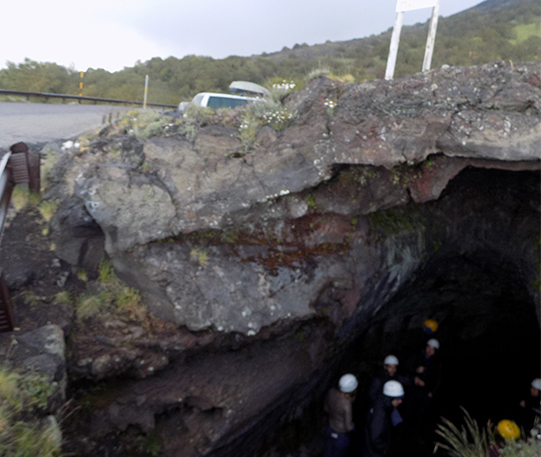
By Mark Leatherman
In May of 2019, my wife and I were able to enjoy our honeymoon, two weeks in Italy. It marked my first ever trip into Europe, and I could not skip the opportunity to accomplish another first, seeing my first stratovolcanoes up close and in person! After a great amount of convincing from my non-rockhounding new bride, we were able to book sightseeing time with Italy’s “big three,” Vesuvius, Etna, and Stromboli. Not only are these the only three active volcanoes in Europe, but they also have a very complex story to tell once one delves into their behavior and their constituent rocks.
Mount Vesuvius
In starting our honeymoon in Venice, we proceeded to head southward with our final stop being the island of Sicily. After a memorable jaunt to Rome, our next stop was Naples, the primary base for visiting the historic town of Pompeii and the mountain responsible for its infamous sudden demise in 79 A.D. via a pyroclastic cloud.
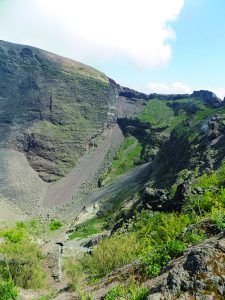
Vesuvius volcano
is composed of
only one central
crater, unlike its
cousin Etna which
is a piecemeal of
multiple craters.
We started our morning with an awe-inspiring tour of Pompeii’s ruins led by a graduate student of archaeology, Francesca, from the University of Naples. This cataclysm is primarily controlled by the fact that Vesuvius is classified as a composite volcano (a.k.a. stratovolcano). These volcano types occur at subduction zones, where a thin, but heavy oceanic plate subducts under a thicker, more buoyant continental plate. In this case, it is the African Plate subducting under the Eurasian Plate. Evaporating water from the down-going oceanic plate interacts and lowers the melting point of the mantle wedge above, creating magma that ascends to the surface.
Since said magma has incorporated the water vapor needed for melt generation, as well as other key elements and gases during its rise, eruptions associated with subduction are typically on the explosive side.
Although we had yet to ascend the mountain itself, we already experienced our first sampling of the variety of eruptive igneous rocks Vesuvius produced. Near the end of our tour, after viewing mostly structures made from marble, we were able to see some low-lying rooms and barriers made from a combination of yellow pumice and weathered tephrite. In general, Vesuvius erupts a myriad of rocks from across the igneous chemical spectrum. This includes felsic (light color-rich in silica, aluminum, sodium, and potassium), mafic (dark color-silica poor-rich in iron and magnesium), and those in-between (intermediate composition).
Composite volcanoes that are land-bound are known to produce eruptive rocks that are typically intermediate to felsic. The pumice is a lightweight felsic rock littered with gas-voids (where the yellow shades found here are a result of weathering). The tephrite is a type of intermediate rock composed of small and coarse crystals (the latter precipitating from underground magma, whereas the latter is cooled erupted lava that carried the larger pre-formed crystals to the surface). This is termed a porphyritic texture. Intermediate porphyry rocks are all but typical with stratovolcanoes, but these tephrites are a little different than their far-more common cousins, termed andesites. Tephrites differ in that they have no quartz, but a nominal presence of feldspathoid minerals (I call them “feldspar wannabes”), such as nepheline (Na, K)AlSiO4 and leucite (KAlSiO3).
After enjoying a pizza lunch on the slopes of Vesuvius, our tour bus took us up to the parking trailhead, wherein we began a twenty-minute hike to the main crater. Along our ascent, the two dominant rock types we encountered were fresh blue-green tephrites and brick red scoria. After taking in the sights (and smells) of this inaugural visit to a stratovolcano crater, we enjoyed a short rolling-in of a wall of fog that obscured our panoramic view of Naples in the distance and made us feel like we had stepped foot on another planet!
Mount Etna
After three days of relaxation along the Amalfi Coast, we took an overnight train to the famed island of Sicily to begin the last leg of our honeymoon. Although some sadness crept in, being near the end of the trip, I knew that the action was just about to heat up! We stayed in the town of Taormina and arranged a sunset tour of the southern portion of Etna. Once our guide, Giuseppe, collected four other tourists, we made our way through Catania; a town notably worn by time, nature, and economics.
The afternoon’s festivities began with a delightful stop serving as one benefit of Etna’s presence; a tasting of products made from the volcano’s fertile soil. Some of the delicacies sampled included: honey, wine, olives, and figs. After a half-hour of satisfying our palates, we continued upward the southern slope of Etna. With this volcano being the tallest in Europe, a drastic temperature change quickly set in from that of Catania, requiring us to bust out sweatshirts. Our first adventurous stop was to explore a small, recently-discovered lava cave right off the main road. While waiting for a prior tour group to wrap up their visit, I had some time to again explore some of Etna’s constituent rocks. While standing on black vesicular basalt flows, I noticed that we had parked right next to a raised mound composed of pahoehoe textures; a Hawaiian-based name used to refer to lava that cooled in a pattern resembling twisted ropes (or Laffy-Taffy).
As I picked up and gazed over these rocks with glee, I had a small sense of disappointment as I assumed that I couldn’t take anything due to the mountain being a national park. The expression on my face must’ve caught Giuseppe’s attention, and I didn’t have to say much for him to explain that I could take home souvenirs. I was somewhat-shocked that the Italians had different attitudes for collecting in such areas than us Americans. If only I would’ve known that sooner, I would’ve added Vesuvius rocks to my luggage (the rock pictures I show here from that tour were all I acquired; oh well!).
After a brief fifteen-minute wait, it was our group’s turn to descend into the dark lava tubes. In comparison to the sprawling lava tubes in Hawaii, Etna’s tubes are not as extensive, since the lavas here are quite viscous, and do not flow as far from their eruptive centers.
Nonetheless, the tubes of Etna proved to be cozy and provide temporary shelter from the
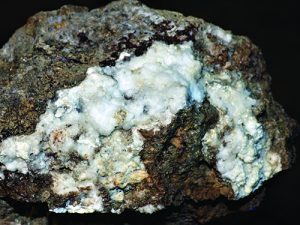
near-freezing rain outside. Along the tube walls, we found small, albeit very interesting flora growing as well as large pothole-like features. The latter is caused by anomalously large gas bubbles escaping the cooling lava. After taking pictures and becoming acclimated to our surroundings, Giuseppe led us along another subterranean path where we stopped at a constructed barrier. If we had gone any further, we would have experienced an approximate twenty-five drop into sheer darkness. Overall, the lava tube tour was short but very sweet.
We continued up Etna’s slopes, in foggy and cold precipitation conditions, before we stopped at a closed tourist building right next to a sign highlighting our next fun short venture; the Silvestri Crater. The crater is one of Etna’s smaller eruptive centers, which is now classified as extinct (last erupted in 1892). It is also redder (has more scoria) than our first stop. Although not the topmost, nor active, it was still a cool experience to walk downslope, especially after we learned that the band Coldplay shot part of their music video for “Violet Hill” at the same spot. It was also here that Mother Nature decided to have some fun with us, in the form of a burst of more intense fog and cold whipping wind that made our group scurry back to the tour vehicle.
Although we could barely feel our faces, we were all in very jolly spirits. We then headed to one of the remaining souvenir/restaurant shops open late in the day. Upon entering, we were regaled by a postcard stand with illustrations of how the shop came devastatingly close to being engulfed by a lava flow during an early 2000s eruption. With the weather continuing to become exceedingly foggy and darker, unfortunately, we couldn’t enjoy the namesake of this part of the tour, and view a fiery sunset (even more reason to come back in the future!).
As we descended toward Catania, we were treated to one more history-filled stop, which included remnants of a 1980s flow that had engulfed a two-story house. It was also here that we observed our first deposits of light-colored welded ash tuff. As luck would have it, three days after our visit, Etna decided to make some fresh tuff and come alive once again. My wife Courtney’s response was along the lines of “Phew, glad we were safe”, whereas my geologist response was more like “Darn, we missed the good action!”
Stromboli
The last stop on our tour of fire had us set sail onto the Tyrrhenian Sea toward the island of Stromboli (which bears the namesake volcano). Our tour bus made its way, an hour north, to the port town of Messina, where we boarded a small cruise ship. En route to the volcano, we stopped at the island of Panarea for lunch and additional sightseeing. The island itself is an extinct volcano that is part of the Aeolian Island Arc, alongside Stromboli and the islands of Vulcano, Lipari, Salina, Filicudi, and Alicudi.
A big positive about visiting these islands, from a rockhounding standpoint, is that collecting samples is very easy since they compose the entire island (with no strenuous hike to a volcanic summit necessary). Right on the shore of Panarea, I was able to acquire some interesting samples of welded ash tuff, porphyritic andesite – with feldspar and hornblende phenocrysts – and scoria with intriguing chalcedony and common opal mineralization. Some sources also indicate that this island also hosts massive sulfide mineralization (i.e. galena, sphalerite, pyrite) with galena in altered sediments in the shallow marine realm just off the island. Too bad
I forgot to bring my scuba gear.
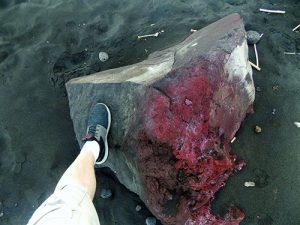
boulders, such as
this hybrid of dark
basalt and red
scoria, can be found
in many places along
Stromboli Island’s
black sand beaches
After three hours on Panarea, it was a straight-shot to Stromboli where we would spend the last three hours of our evening. Since a hike to the volcano’s rim was out of the question, due to tiredness and a compressed time window, we were content with hiking around the town proper. As we did so, we were able to take in the sounds of the mountain rumbling to life with its very frequent eruptions (roughly one every 1-2 hours). After exploring the town’s narrow alleys, shops, and grabbing dinner, Courtney and I walked along the island’s notable black sand beaches composed of weathered pyroxene, amphibole, and magnetite. On the beach were large volcanic boulders of scoria and vesicular basalt fused with pyroclastic tuff worth sampling, as well as another first for me, seeing my first beached jellyfish up close (and in the wild and not an aquarium).
The time sure did go by fast as we saw some fellow cruise passengers making their way back to the boarding dock, so we made haste as well (all the while watching where we were stepping).
After everyone returned to the dock, the boat proceeded to circle the island to take in some dark sea stacks brilliantly set against an orange and navy-blue Mediterranean sunset. After twenty minutes of circling, we were in sight of the main eruptive slope of Stromboli, which locals refer to as “fire street” (or via del fuoco).
This is where the mountain’s frequent eruptions can be witnessed from a safe distance (our boat was a kilometer away from the shore). The flow slope is incredibly well-defined given Mother Nature’s penchant to not always follow the rules.
During our visit, the clouds and wind threatened to put a damper on nature’s light show. As I stood on the boat’s top deck, eagerly having the video function on my camera at the ready, I was able to capture a small sliver of lava followed by a small plume of ash. Although not as spectacular as what is commonly seen, with the fire street covered in a river of red, I nonetheless finally saw my first eruptive activity in person! I still counted the event as a completed task on my geologist bucket list. As the cloud cover did not let up, we ultimately made our way back towards Sicily. With one more sleep, our honeymoon sadly ended, but Courtney and I vowed to return someday, hopefully with an improved encore waiting in the wings.
Similar, But Different
In introductory geology courses, stratovolcanoes are described as products of an oceanic plate subducting under a continental plate, as described before with Vesuvius. The subduction process releases hot water vapor from the wet oceanic crust to the overlying mantle wedge, which lies underneath the overriding continental plate and produces magma. As the magma rises towards the surface, it may or may not erupt like a volcano, then cool as extrusive igneous rocks. Typically, in this setting, said rocks include andesites, dacites, and rhyolites (intermediate to felsic composition) with minor basalts.
However, the making of Vesuvius is “slightly” odd, involving the subduction of the African
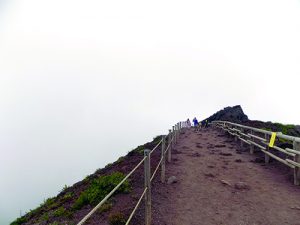
down Vesuvius,
we had a sudden
front of fog move
in to make the
environment quite
surreal-looking.
Plate moving northward underneath the European Plate. Instead of the mainstream subduction processes outlined above, the head (or subducting front) gets decapitated in a process called delamination. This creates a void between the head and “body” of the African plate where deeper mantle material wells up to “fill the void”, like blood filling in a space to clot a cut. This deeper mantle material is just one mechanism in which Vesuvian igneous rocks can slightly differ in their geochemistry. Additionally, as magma rises, there can be differing degrees of crust contamination (or assimilation), further giving rise to the range of rocks that form.
Found alongside the “typical” andesites, dacites, and rhyolites is an unusual igneous rock called tephrite; a basaltic rock containing the minerals nepheline and leucite. The latter two minerals are termed feldspathoids, which form under silica undersaturated conditions (typically, but not limited to, low quantities of partial melting from the mantle). Out of Italy’s “big three”, Vesuvius might have the easiest origin to explain!
In referring again to what is typically learned in an introductory geology class, along with subduction zones, volcanism can also occur where plates spread apart (at divergent boundaries), and hot spots (where anomalously hot deep mantle material reaches the crust that can be in the middle of plates). The island of Etna does not fit into any one of the three scenarios. Etna does indeed sit near the African Plate subduction zone but is located a little too far from where it should be. To add to the frazzling puzzle, the area contains several slivers of crust jammed up around the subduction area (also called accreted terranes).
Lastly, Etna sits in an area composed of a complex crisscrossing set of many different faults formed from compression and extension (usually a set of faults in an area arise from one type of stress or one type of plate boundary). This chaotic combination has led to multiple igneous rock types produced from basalt, welded ash tuff, sodium alkaline rocks (such as phonolite), and peralkaline rhyolite (containing somewhat more p otassium feldspar and lesser quartz than usual); rocks typically learned in an upper-level geology course. The complex crisscrossing faults is also likely to explain why Etna (and Stromboli discussed below) erupts quite frequently for a stratovolcano, with multiple easy passages for magma to ascend relatively quickly.
One theory that attempts to explain this eclectic combination of rocks is that Etna rests in an area that is considered a mix between subduction and crustal rifting origins. Some geophysical studies have shown that a part of the subducting African Plate has developed a tear in it, leading to a mantle convection current (anomalously hot material) further away from the subduction zone, and hence resulting in the generation of magma in an unusual spot. Despite this, the main magma source for Etna eruptions is still poorly understood.
The island of Stromboli is just as complex in its own slightly different ways. The variety of rocks produced here is a combination of healthy amounts of basalt (significantly more so than Vesuvius), scoria, andesite, dacite, rhyolite, and less typical potassic-alkaline rocks (elevated quantities of potassium) which include trachyte, latite, shosohonite, and trachybasalts. In fact, potassic-alkaline rocks are relatively rare worldwide, but very widespread in this region. Thus, it should bear mentioning that the genesis of potassium-rich magmas is still a subject of debate among geologists.
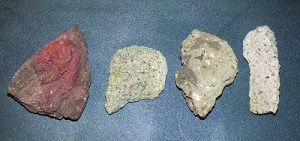
In summary, the myriad of volcanic rocks and minerals found amongst all of Italy’s volcanoes can be envisioned as a gigantic, complex Venn diagram, with many overlappings as well as unique differences. Even with all my attempts to explain the above in a simplistic sense, there are still multiple other models – not touched on here – attempting to explain the very perplexing nature of Etna and Stromboli, with plenty of currently unresolved questions.
The flipside to this is the allure and intrigue of the unresolved that attracts many a volcanologist and visitor to this region, time and time again.














